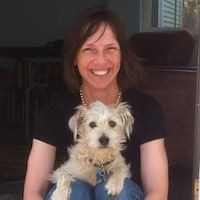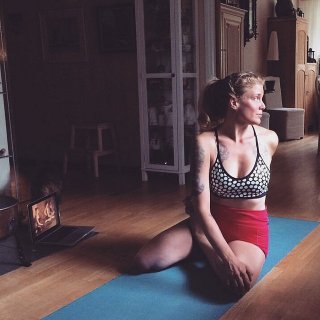

What do you say to yourself when you’re alone on the yoga mat?
Are you practicing ahimsa to yourself? Being kind?
In a class, the teacher provides direction and images to guide the body and focus the mind. The teacher encourages.
Alone, though, our internal dialogue can be a distraction. If we lose ourselves in ego’s achievement trap, this dialogue may even discourage as we zoom in on can’ts and shoulds. Avoidance of these impish mental interjects might keep you from practicing. Don’t let ‘em.
Home practice is where lasting insights occur. Home practice is where, absorbed in the solitude of single-pointed attention, we reach places physically that surprise us.
I know about home practice. In 2009 when the Great Recession placed its giant thumb on my family’s finances, I took a year-long hiatus from studio classes. I was broke. Yet, the cloud of this global financial collapse did indeed hold a silver lining for this yogini. When that door to my weekly happy time in the bamboo-floored, blanket-blessed space closed, a window opened in the tiny combo guest room/office/TV room/storage room of my little house.
At that point, I’d been practicing yoga steadily for 15 years.
Whenever I moved to a new city, I’d sign up for water and power service, then locate the grocery store, then a yoga studio to befriend. So I had a solid foundation of instruction on which to build a home practice. I’d just never bothered much with it before.
Determined to not let my practice slip even as my checking account slid, I borrowed yoga DVDs from the library, browsed used book stores for asana guides and subscribed to yoga magazines. Guess what? After a few weeks, I returned the DVDs, traded in the books and let the magazines pile up with the newspapers.
I discovered that if I made one simple shape, even sitting in sukhasana, cross-legged on the mat or floor, I’d keep going and going as I accessed the simple joy of movement and breath.
My home practice became my true practice. Now, as a full-time yoga teacher, I live by this quote attributed to Judith Lasater: “Practice for your students, teach for yourself.”
My home practice is not class planning. When I enter the nook of zafu, mat, blankets and blocks that I’ve created under the eave, I clarify whether I’m practicing yoga or preparing a lesson. Prepping is analytical—for the students and their needs and interests—and requires outlining a plan that creates causes and conditions for them to have a growth experience.
Home practice is organic, intensified and fueled by open-ended curiosity. It’s stoked by questions; it’s lightened by laughter and deepened by tears. It’s unique.
 It can be helpful to ask precise, what are sometimes called “closed” questions as well as imaginative, open-ended ones. The closed questions typically start with “what, ” “when, ” and “where.” They inform the physical pose. The open-ended typically start with “how, ” “why, ” “could, ” “would, ” and “I wonder.” They engage the imagination and feelings.
It can be helpful to ask precise, what are sometimes called “closed” questions as well as imaginative, open-ended ones. The closed questions typically start with “what, ” “when, ” and “where.” They inform the physical pose. The open-ended typically start with “how, ” “why, ” “could, ” “would, ” and “I wonder.” They engage the imagination and feelings.
In combination, they help activate self-knowledge.
Below are some from my own practices and some shared by my students to get you going. Enjoy!
Where shall I start?
What if I take a seat?
Where do I feel the breath?
What is its texture?
What is its rhythm?
What happens if—?
In what way might a tiny adjustment change the experience?
Is that it?
Could I hold steady here for one more breath? Two?
What emotion emerges?
Where am I feeling this?
Where can I stabilize?
Where am I breathing?
What about this side?
How does it feel?
Where is the balance between effort and ease?
I wonder why—?
Could I let go of ‘why’?
Where am I holding?
Can I let go?
What if I try this tomorrow?









